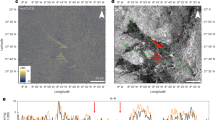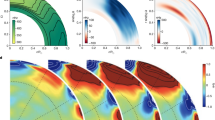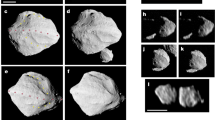Abstract
DURING June of every year, the radio source Taurus-A passes within a small angular distance of the Sun. This particular situation, commonly referred to as the occultation of Taurus-A by the Sun, permits an investigation of the Sun's outer corona as the radio source is viewed through it. The measurements made over the past several years have demonstrated that the radiation from the source is scattered at the electron density irregularities in the corona; as a result one observes an apparent broadening of the source accompanied by a decrease of its intensity. The effect becomes larger with decreasing angular separation of the source from the Sun. This phenomenon has been observed in the range of frequencies 26–178 Mc/s1–5. At wave-lengths of 6 and 18 cm the effect has been reported to be negative6,7, except that a positive result has been reported on 10- and 25-cm wave-lengths8. The results on all metre and decametre wave-lengths are consistent and are in accordance with the theory of small-angle multiple scattering, in which the angular size of the scattered distribution is proportional to the square of the wave-length. However, the increase of intensity on 169 Mc/s at 7 R0 (R0 is the photospheric radius) from the centre of the Sun is not consistent with the theoretical prediction based on the lower frequency data5. In order to investigate if the coronal scattering is still effective at frequencies higher than 169 Mc/s, and in particular to see if the increase of intensity is also observed on 430 Mc/s, we undertook to observe at 430 Mc/s the occultation of Taurus-A by the solar corona in June 1964, using the 1,000-ft. dish of the Arecibo Ionospheric Observatory.
This is a preview of subscription content, access via your institution
Access options
Subscribe to this journal
Receive 51 print issues and online access
$199.00 per year
only $3.90 per issue
Buy this article
- Purchase on Springer Link
- Instant access to full article PDF
Prices may be subject to local taxes which are calculated during checkout
Similar content being viewed by others
References
Hewish, A., Proc. Roy. Soc., A, 228, 238 (1955).
Hewish, A., Mon. Not. Roy. Astr. Soc., 118, 534 (1958).
Vitkevitch, V. V., Astr. J. U.S.S.R., 37, 32 and 961 (1960).
Blum, E. J., and Boischot, A., The Observatory, 77, 205 (1957).
Erickson, W. C., Astrophys. J., 139, 1290 (1964).
Hughes, M. D., Downes, D., and Murray, C., Astrophys. J., 139, 404 (1964).
Wyndham, J. D., and Clark, B. G., Nature, 200, 766 (1963).
Basu, S., and Castelli, J., Nature, 197, 885 (1963).
Högbom, J. A., Mon. Not. Roy. Astr. Soc., 120, 530 (1960).
Author information
Authors and Affiliations
Rights and permissions
About this article
Cite this article
KUNDU, M. Occultation of Taurus-A by the Solar Corona at 430 Mc/s in June 1964. Nature 205, 683–684 (1965). https://doi.org/10.1038/205683a0
Published:
Issue Date:
DOI: https://doi.org/10.1038/205683a0
Comments
By submitting a comment you agree to abide by our Terms and Community Guidelines. If you find something abusive or that does not comply with our terms or guidelines please flag it as inappropriate.



